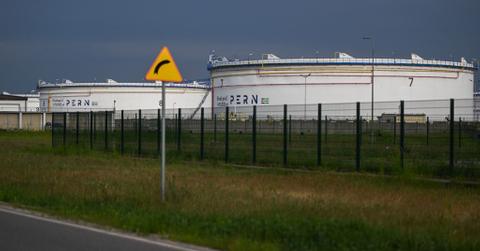Oil Prices Fall 10 Percent — Here’s What’s Happening
Oil prices tumbled below $100 per barrel. Here’s what it means for the economy and when consumers might get relief. So far, 2022 has been eventful for oil.
July 6 2022, Published 11:46 a.m. ET
After an eventful first half of the year, the energy industry is maintaining its drama as oil prices fell around 10 percent practically overnight. Still, consumers await more pullback at the pump as road trips remain out of reach for many Americans.
Here’s why oil prices are falling, the conflicted impacts it has on the country, and when consumers might get some relief at the pump.
Oil prices stumble below $100 per barrel in swift move.
According to the main U.S. oil benchmark, the West Texas Intermediate (WTI) crude, oil prices fell majorly on Tuesday, July 5. Prices fell as much as 10 percent at one point (down to $97.43 per barrel, below $100 for the first time since May 11). The WTI index settled around $96.09 near mid-day on Wednesday, July 6.
From an international perspective, the Brent Crude Oil Continuous Contract hit $99.28, which is over 10 percent lower.
Are lower oil prices a sign of deflation?
With all this inflation eating away at consumers’ pockets, a sharp decline in oil prices feels almost unfit. However, it could be a sign of deflation — and consequently a recession — to come.
Because of the bumpy nature of the current oil price tumble, experts fear that bumpiness will translate into the larger economy moving forward, suggesting a difficult egress out of inflationary pressures.
Why oil prices are falling
According to a note to clients from Ritterbusch and Associates, the fall in gas prices is a result of “tightness in global oil balances increasingly being countered by the strong likelihood of recession that has begun to curtail oil demand.”
The firm added that the “oil market appears to be homing in on some recent weakening in apparent demand for gasoline and diesel.”
When will consumers see gas prices fall?
Gas prices are already beginning to fall at the pump — albeit slowly. The national average cost per gallon of gas hit $4.79 on July 6, down from the highest recorded average price of $5.016 on June 14.
The reason consumers feel inflation more than wholesalers is because companies use increased profit margins to pad their bottom line for a potential economic crisis. Other factors, like the rising cost of refining and the heightened threat of natural disasters, also play a role. Among all of this, individuals are left with the bill longer than they may otherwise have been.
Last week, Biden wrote on Twitter, “My message to the companies running gas stations and setting prices at the pump is simple: this is a time of war and global peril. Bring down the price you are charging at the pump to reflect the cost you’re paying for the product. And do it now.”
In response, Amazon founder and billionaire Jeff Bezos criticized Biden for where he placed his blame. Regardless of the scuffle, two things are clear: Tumbling oil prices mean a potential upcoming recession could get messy, and consumers may bear the brunt.


